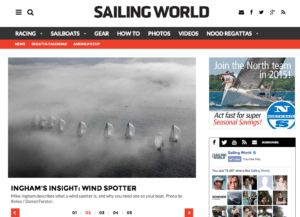
Lowell North
When Lowell North was 14 years old his father gave him a Star to sail in San Diego, where the family had relocated from Newport Beach, Calif., just up the coast. The elder North, a geophysicist by trade, crewed for his son during their first year of racing. They finished last in every race, but the following season young Lowell turned his attention to his sails, intuitively sensing that the shapes just didn’t look right. He re-cut his cotton mainsail on the family’s garage floor, and after rebuilding it several times, produced a final product that was so fast it prompted Malin Burnham—one of San Diego’s hottest sailors at the time—to recruit him for the 1945 Star World Championship.
“It wasn’t me Malin wanted,” he once famously said. “It was my mainsail.”
The pair won the Worlds that year, when Lowell was only 15—and he went on to win four additional Star World titles. He was the talk of San Diego.
Fast-forward 68 years to June 2013: 83-year-old Lowell had the local sailors talking once again, this time about how he deftly steered Tom Siebel’s MOD70 trimaran Orion in the waters off San Diego’s Point Loma. He rarely accepts invitations to go sailing these days, but he did so when his friend John Gladstone invited him on a high-speed, three-hull burn around San Diego Bay. The minute Lowell saw a photo of the 70-footer, says Gladstone, he was all for the outing.
The MOD70 concept was born in France in 2010, and the class has enjoyed a brief run of high-profile inshore and offshore races. Siebel brought one to the West Coast, far removed from its French sisterships, in order to bring a new look to the area’s performance sailing scene. Bringing Lowell out for a spin was a logical step. He’d never before been on a boat anything like Orion, but it didn’t matter one bit.
Excitement was visible in his eyes as he steered Orion from the sculpted white helmsman’s chair on the windward ama. He looked perfectly at ease tucked in behind a small spray shield with the tiller in hand, all senses firing. “I’m a little too old to make a good crew, but they let me steer for a while,” he said after sailing. “With the mast canted to weather I kept hoping it wouldn’t fall down [to leeward]. It was a big, big boat and a really big mast. I was amazed by the whole thing.”
The boat had a heavy helm, but it was extremely responsive in the day’s 12-knot breeze, and it accelerated quickly, he said, admitting that his first experience on a modern-day multihull was “exciting, scary, and enjoyable.”
“I didn’t have an apparent-wind dial in front of me,” he said. “But they told me our boatspeed was always quite a bit more than the windspeed, which was pretty amazing when you think about it.”
Lowell’s top speed on this day was 23 knots. “He immediately understood the apparent-wind angle effects and the necessity to keep it forward,” said crewmember Patrick Murray. In fact, there was unanimous agreement among the invited guests and crewmembers that Lowell was one of the better drivers onboard that day. No surprise there.
As the America’s Cup approaches, I can’t help thinking about the relevance of Lowell’s simple afternoon outing on the MOD70. He’s seen and sailed a lot, but where we’re at today, with unthinkable speeds and technology, has taken us so far beyond the days of his re-cut cotton Star sail. We’ve reached an era where the technology in our hulls, masts, sails, instruments, rudders, and wings is superseding anything he, or any of us, ever thought possible. It’s an exciting time for our sport, and more importantly, for the spectators and sponsors connected with the America’s Cup. It’s also one with a lot of anticipation and uncertainty. “It’s going to be very exciting watching those 72-footers thrash about,” said Lowell, who’s looking forward to watching the America’s Cup. “It’s a very good trend and makes sailing more exciting to watch.”
Lowell says he’s happy to watch the races from home, but I bet if he were offered a spot onboard he’d be there—holding onto his signature white hat and thinking about how he’d make the darn thing go even faster.
This article first appeared in the September 2013 issue of Sailing World. Click here to read more from Ken Read.









